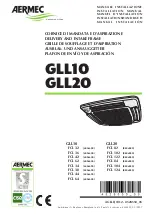
127915-YIM-A-0405
52
Unitary Products Group
PHASING
Check for proper compressor rotation. If the blower or
compressors rotate in the wrong direction at start-up,
the electrical connection to the unit is misphased.
Change the incoming line connection phasing to obtain
proper rotation. (Scroll compressors operate in only
one direction. If the scroll is drawing low amperage,
has similar suction and discharge pressures, or pro-
ducing a high noise level, the scroll is misphased).
CHECKING SUPPLY AIR CFM
The RPM of the supply air blower will depend on the
required CFM, the unit accessories or options and the
static resistances of both the supply and the return air
duct systems. With this information, the RPM for the
supply air blower and the motor pulley adjustment
(turns open) can be determined from the Blower Per-
formance Data Tables.
Note the following:
1.
The supply air CFM must be within the limitations
shown in the Unit Application Data Table 1.
2.
Pulleys can be adjusted in half turn increments.
3.
The tension on the belt should be adjusted as
shown in the Belt Adjustment Figure 17.
FIGURE 16 - CHARGING CHART - 25 TON
DR300 Charging Chart
150
170
190
210
230
250
270
290
310
330
350
55
60
65
70
75
80
85
115º
105º
95º
85º
75º
65º
Outdoor Temp (ºF)
Suction Pressure (psi)
Discharge Pressure (psi
)
Both fans must be running when charging the unit. One fan may switch off at low ambient temperatures making this chart inaccurate.
Scroll compressors require proper rotation to
operate correctly. Do not change the internal
wiring to make the blower, condenser fans, or
compressor rotate correctly. Change the
incoming power to the main terminal block to
obtain proper rotation.
FIGURE 17 - BELT ADJUSTMENT
Loosen nuts (A) (top and bottom).
Adjust the tension by turning bolt (B).
Never loosen nuts (C) from each other.
Use a belt tension checker to apply a perpendicular force to be one belt at the
midpoint of the span as shown. The deflection force should be applied
until a specific deflection distance of 4mm (5/32") is obtained. To determine
the deflection distance from normal position, use a straight edge from
sheave to sheave as a reference line. The recommended deflection force
is as follows:
1.
2.
3.
4.
PROCEDURE FOR ADJUSTING BELT TENSION:
Tension new belts at the max. deflection force recommended for the belt
section. Check the belt tension at least two times during the first 24 hours of
operation. Any re-tensioning should fall between the min. and max.
deflection force values.
5. After adjusting, re-tighten nuts (A).
*Never Loosen
(A)
(C)*
(B)
SPAN LENGTH
DEFL FORCE
















































